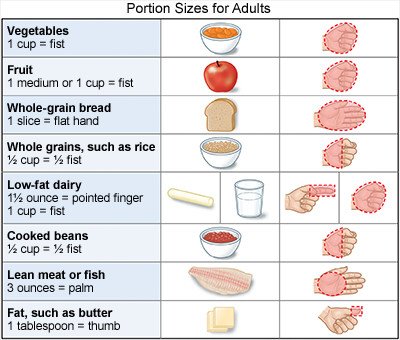Measurement List
Medically reviewed by Drugs.com. Last updated on Aug 4, 2025.
It is helpful to measure food servings if you need to limit calories in your diet to lose weight. You should also measure foods if you follow a special diet in which you need to limit or eat more of certain foods. Special diets include low-fat diets, low-sodium diets, carbohydrate counting diets, and high-protein diets.
DISCHARGE INSTRUCTIONS:
Difference between a portion size and a serving size:
- The portion size that you normally eat and the serving size that you should eat may be different. A portion size is the amount of a food that you choose to eat at any one time. A portion size is also the amount of food you are served in a restaurant.
- A serving size is a standard measurement of food that is recommended in dietary guidelines. Guidelines for special diets also use serving sizes to describe the amount of food you should eat. It is important to know what an actual serving size looks like. This helps you to make sure you eat the right amount of food. The best way to learn what a serving size looks like is by measuring the food.
How to measure foods:
You can measure serving sizes using a scale, measuring cup, and measuring spoons. Measure food at home until you learn what serving sizes of different foods look like. Learn how to convert measurements so that you can convert a portion size to a serving size. The portion size of a packaged food may be listed in ounces, but you may want to measure your serving in cups.
How to convert liquid measurements:
- 1 teaspoon (tsp) = 5 milliliters
- 1 tablespoon (Tbsp) = 3 teaspoons = about 15 milliliters
- 1 fluid ounce (fl. oz) = 2 tablespoons = 28 milliliters (often rounded up to 30 milliliters)
- ½ cup = 4 fluid ounces = 120 milliliters
- 1 cup = 8 fluid ounces = 240 milliliters
- 1 pint = 2 cups = 16 fluid ounces = 480 milliliters
- 1 quart (qt) = 4 cups = 2 pints = 32 fluid ounces = 950 milliliters
- 1 gallon = 4 quarts = 128 fluid ounces = 3.8 liters (L)
How to convert weight measurements:
- 1 gram (g) = 1000 milligrams (mg)
- 1 ounce (oz) = 28 grams
- 1 kilogram (kg) = 1000 grams = 2.2 pounds
- 1 pound = 16 ounces = 454 grams
How to figure out serving sizes when you are away from home:
You should have an idea of what a serving size looks like if you have been measuring foods at home. You can also estimate a serving size by comparing it to the size of a familiar object. Use the following guidelines to compare common serving sizes with familiar objects.
- ½ cup of rice, pasta, cooked vegetables, or fruit is about the size of half of a baseball
- 1 cup of cereal is about the size of a baseball
- 1 small fruit, such as an orange or apple, is about the size of a tennis ball
- 1½ ounces of hard cheese is about the size of 4 stacked dice
- 1 teaspoon of margarine or spread is about the size of 1 dice
- 3 ounces of cooked meat, fish, or poultry is about the size of a deck of cards
- 2 tablespoons of peanut butter is about the size of a ping-pong ball
 |
© Copyright Merative 2025 Information is for End User's use only and may not be sold, redistributed or otherwise used for commercial purposes.
The above information is an educational aid only. It is not intended as medical advice for individual conditions or treatments. Talk to your doctor, nurse or pharmacist before following any medical regimen to see if it is safe and effective for you.
Further information
Always consult your healthcare provider to ensure the information displayed on this page applies to your personal circumstances.
